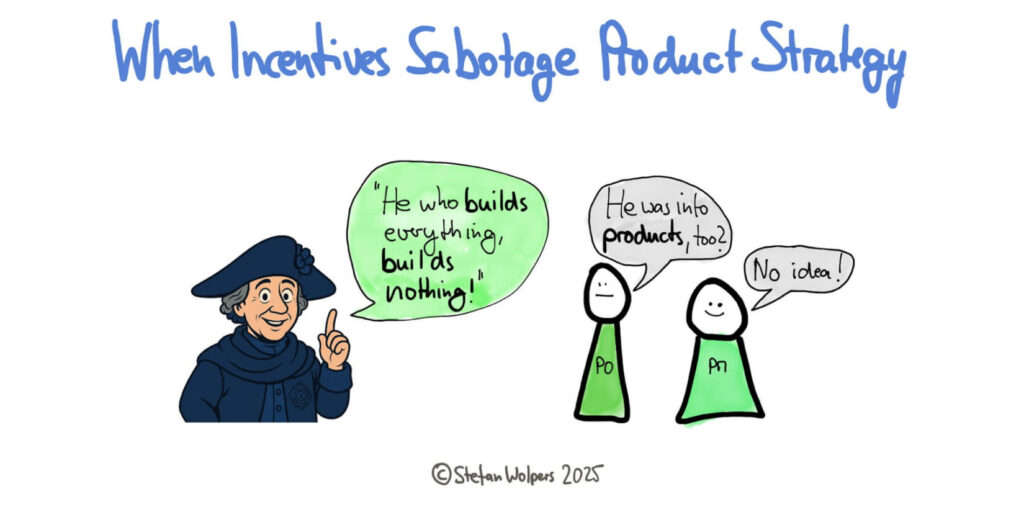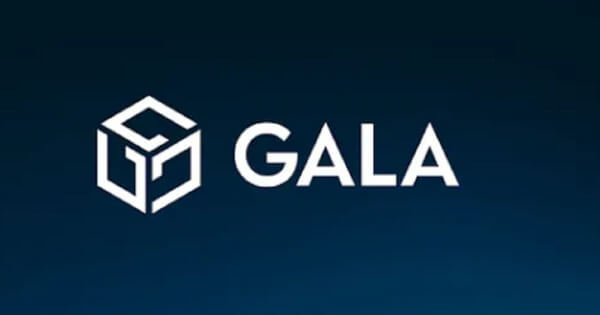TL;DR: When Incentives Sabotage Product Strategy
Learn why many Product Owners and Managers worry about the wrong thing: saying no instead of saying yes to everything. This article reveals three systematic rejection techniques that strengthen stakeholder relationships while protecting product strategy to avoid that organizational incentives sabotage product strategy.
Discover how those drive feature demands, why AI prototyping complicates strategic decisions, and how transparent Anti-Product Backlog systems transform resistance into collaboration.

🗞 Shall I notify you about articles like this one? Awesome! You can sign up here for the ‘Food for Agile Thought’ newsletter and join 42,000-plus subscribers.
🎓 🖥 🇬🇧 The AI-Enhanced Advanced Product Backlog Management Course Version 2—July 1, 2025
Are you facing problems aligning vision, stakeholders, your team, and delivering real value?
Is your contribution as a product leader questioned?
Then, prepare to transform your career with my AI-enhanced, comprehensive, self-paced online class. Dive deep into professional Product Backlog management techniques supported by videos, exercises, and the latest AI models.
👉 Please note: The course will only be available for sign-up until July 7, 2025!
🎓 Join the Launch of the AI-Enhanced Version 2 on July 1: Learn How to Master the Most Important Artifact for any Successful Agile Practitioner!
The Observable Problem: When Organizational Incentives Create Anti-Product Behaviors
Product Owners and Managers often encounter a puzzling dynamic: stakeholders who champion features that clearly misalign with product strategy, resisting rejection with surprising intensity. While individual stakeholder psychology gets attention, the more powerful force may be systemic incentives that reward behaviors incompatible with desired product success.
Charlie Munger’s observation proves relevant here: “Never, ever, think about something else when you should be thinking about the power of incentives.” Few forces shape human behavior more predictably than compensation structures, performance metrics, and career advancement criteria.
Consider the sales director pushing for a dashboard feature that serves three enterprise prospects. Their quarterly bonus depends on closing those deals, rationalizing the feature request from their incentive perspective, even if it contradicts product strategy. The customer support manager advocating for complex workflow automation may face performance reviews based on ticket resolution times, not customer satisfaction scores.
These aren’t character flaws or political maneuvering. They’re logical responses to organizational incentive structures. Until Product Owners and Managers recognize incentive patterns driving stakeholder behavior, rejection conversations will address symptoms while ignoring causes.
The challenge compounds when organizations layer agile practices onto unchanged incentive systems. Teams practice “collaborative prioritization,” while stakeholders receive bonuses for outcomes that require non-collaborative resource allocation. The resulting tension manifests as resistance to strategic rejection, which Product Owners and Managers often interpret as relationship problems rather than systems problems.
The Generative AI Complication: When Low-Cost Prototyping Enables Poor Strategy
Generative AI introduces a new dynamic in that may make strategic rejection more difficult: the perceived reduction in experimentation costs. Stakeholders can now present Product Owners with quick prototypes, mockups, or even functioning code snippets, arguing that implementation costs have dropped dramatically: “Look, I already built a working prototype in an hour using Claude/ChatGPT/Copilot. How hard could it be just to integrate this?” becomes a common refrain. This generally beneficial capability creates an illusion that feature requests now carry minimal technical debt or opportunity cost.
The fallacy proves dangerous: running more experiments doesn’t equate to delivering more outcomes. AI-generated prototypes may reduce initial development time but don’t eliminate the strategic costs of unfocused Product Backlogs. Regardless of implementation speed, every feature (request) still requires user research, quality assurance, maintenance, support documentation, and, most critically, cognitive load from users navigating increasingly complex products.
Worse, the ease of prototype generation may push teams toward what you may call the “analysis-paralysis zone:” endless experimentation without clear hypotheses or success criteria. When stakeholders can generate working demos quickly or assume the product team can, the pressure to “just try it and see” intensifies, potentially undermining the strategic discipline that effective product management requires.
Product Owners need frameworks for rejecting AI-generated prototypes based on strategic criteria rather than technical feasibility. The question isn’t “Can we build this quickly?” but “Does this experiment advance our strategic learning objectives?”
Cannot see the form? Please click here.
Questioning Assumptions About Stakeholder Collaboration
The Agile Manifesto’s emphasis on “collaboration over contract negotiation” may create unintended consequences when stakeholder incentives misalign with product strategy. While collaboration generally produces better outcomes than adversarial relationships, some interpretations of collaboration may actually inhibit strategic clarity.
Consider this hypothesis: endless collaboration on fundamentally misaligned requests might be less valuable than clear, well-reasoned rejection. This approach contradicts conventional wisdom about stakeholder management, which may not account for modern incentive complexity.
The distinction between outcomes (measurable business results) and outputs (features shipped) becomes critical here. Stakeholder requests typically focus on outputs, possibly because their performance metrics reward feature delivery rather than business impact. However, optimizing for stakeholder comfort with concrete deliverables may create “feature factories,” organizations that measure success by shipping velocity rather than strategic advancement.
Understanding stakeholder incentive structures seems essential for effective rejection conversations. Stakeholder requests aren’t inherently problematic, but they optimize for individual stakeholder success rather than product strategy coherence. Effective rejection requires acknowledging these incentive realities while maintaining strategic focus.
The Strategic Framework: A Proven Decision-Making System to Avoid that Incentives Sabotage Product Strategy
The following Product Backlog management graphic illustrates a sophisticated and proven decision-making system many Product Owners and Managers underutilize. It isn’t a theoretical framework; it represents battle-tested approaches to strategic resource allocation under constraint.

The alignment-value pipeline concept demonstrates how ideas flow from multiple sources (stakeholder requests, user feedback, market data) through strategic filters (Product Goal, Product Vision) before reaching development resources. This systematic approach ensures that every feature request undergoes strategic evaluation rather than ad-hoc prioritization.
The framework’s key strengths lie in its transparency and predictability. When the decision criteria are explicit and consistently applied, stakeholders can understand why their requests receive specific treatment. This transparency reduces political pressure and relationship friction because rejection feels systematic rather than personal. Moreover, it applies to everyone, regardless of position.
The Anti-Product Backlog component proves particularly powerful for managing stakeholder relationships during rejection conversations. Rather than dismissing ideas, this approach documents rejected requests with clear strategic rationales, demonstrating respect for stakeholder input while maintaining product focus.
The experimental validation loop directly addresses the generative AI challenge. Instead of building features because prototyping is easy, teams validate underlying hypotheses through structured experiments with measurable success criteria. This approach channels stakeholder enthusiasm for quick prototypes toward strategic learning rather than feature accumulation.
The refinement color coding (green, orange, grey, white) provides tactical communication tools for managing stakeholder expectations. When stakeholders understand that development capacity is finite and strategically allocated, they may begin self-filtering inappropriate requests and presenting others more effectively.
Technique One: Address Incentive Misalignments Before Feature Discussions
Traditional rejection conversations focus on feature merit without addressing underlying incentive structures. This approach treats symptoms while ignoring causes, often leading to recurring requests for the same misaligned features.
Consider starting rejection conversations by acknowledging stakeholder incentive realities: “I understand your quarterly goals include improving customer onboarding metrics, and this feature seems designed to address that objective. Let me explain why I think our current user activation experiments will have a greater impact on those same metrics.”
This approach accomplishes several things: it demonstrates an understanding of stakeholder motivations, connects rejection to shared objectives, and redirects energy toward aligned solutions. You’re working within incentive structures rather than fighting them while maintaining strategic focus.
For AI-generated prototypes, address the incentive to optimize for implementation speed over strategic value: “This prototype demonstrates technical feasibility, but before committing development resources, I need to understand the strategic hypothesis we’re testing and how we’ll measure success beyond technical implementation.”
Document these incentive conversations as part of your Anti-Product Backlog entries. When stakeholders see their motivations acknowledged and addressed systematically, they’re more likely to trust future rejection decisions and collaborate on alternative approaches.
Technique Two: Leverage Transparency as Strategic Protection
The Anti-Product Backlog system provides more than rejection documentation: it creates transparency that protects Product Owners and Managers from political pressure while educating stakeholders about strategic thinking.
Make your strategic criteria explicit and easily accessible. When stakeholders understand your decision framework before making requests, they can self-filter inappropriate ideas and present others more strategically. This transparency reduces rejection conversations by improving request quality.
For each rejected item, document:
- The strategic misalignment (how does this conflict with Product Goal/Vision?)
- The opportunity cost (what strategic work would this displace?)
- The incentive analysis (what stakeholder objectives does this serve?)
- The alternative approaches (how else might we address the underlying need?)
- The reconsideration criteria (what would need to change to revisit this?)
This systematic transparency serves multiple purposes: it demonstrates thoughtful analysis rather than arbitrary rejection, provides stakeholders with clear feedback on request quality, and creates precedent documentation that prevents the same arguments from recurring.
Address AI prototype presentations with similar transparency: “I appreciate the technical exploration, but our Product Backlog prioritization depends on strategic alignment and validated user needs rather than implementation feasibility. Let me show you how this request fits into our current strategic framework.”
Technique Three: Transform Rejection into Strategic Education
Every rejection conversation represents an opportunity to educate stakeholders about strategic product thinking while addressing their underlying incentive pressures.
Connect rejection rationales to measurable outcomes that align with stakeholder objectives: “I understand you need to improve support ticket resolution times. This feature might help marginally, but our planned user onboarding improvements could reduce ticket volume by 30% based on our support analysis, which would have a greater impact on your team’s performance metrics.”
For AI-generated prototypes, use rejection as education about strategic experimentation: “This prototype shows what we could build, but effective product strategy requires understanding why we should build it and how we’ll know if it succeeds. Before committing to development, let’s define the strategic hypothesis and success criteria.”
Reference the systematic process explicitly: “Our alignment-value pipeline shows 47 items in various stages representing 12 weeks of development work. This request would need to demonstrate higher strategic impact than current items to earn prioritization, and I don’t see evidence for that impact yet.”
This educational approach gradually shifts stakeholder mental models from feature-focused to outcome-focused thinking. When stakeholders understand the true cost of product decisions and the strategic logic behind prioritization, they begin collaborating more effectively within strategic constraints rather than trying to circumvent them.
The Incentive Reality: Systematic Causes Require Systematic Solutions
Organizational incentives create predictable stakeholder behavior patterns that individual rejection conversations cannot address. Sales teams get compensated for promises that product teams must deliver. Marketing departments face engagement metrics that feature requests could theoretically improve. Customer support managers need ticket resolution improvements that workflow automation might provide.
These incentive structures aren’t necessarily wrong but often conflict with product strategy coherence. Effective Product Owners and Managers must navigate these realities without compromising strategic focus.
Building Systematic Rejection Capability
Individual rejection conversations matter less than systematic practices that align organizational incentives with product strategy while maintaining stakeholder relationships.
Consequently, establish regular stakeholder education sessions in which you share the alignment-value pipeline framework and demonstrate how strategic decisions are made. When stakeholders understand the system, they can work more effectively within it.
Create metrics that track rejection effectiveness: ratio of strategic alignment in requests over time, stakeholder satisfaction despite rejections, value creation improvements from strategic focus, and business impact metrics from accepted features.
Use Sprint Reviews to reinforce outcome-focused thinking by presenting strategic learning and business impact rather than just feature demonstrations. This gradually shifts organizational culture from output celebration to outcome achievement.
Most importantly, recognize that strategic rejection isn’t about individual skills. Instead, it’s about organizational systems that either support or undermine strategic product thinking. Master the systematic approaches, and you will build products that create sustainable competitive advantage while maintaining stakeholder relationships based on mutual respect for strategic discipline rather than diplomatic accommodation.
Conclusion: Transform Your Strategic Rejection Skills
Most Product Owners and Managers recognize these challenges but struggle with implementation. Reading frameworks doesn’t change entrenched stakeholder behavior patterns; systematic practice does.
Start immediately: Document the incentive structures driving your three most persistent stakeholder requests. Create your first Anti-Product Backlog entry with a strategic rationale. Practice direct rejection language focusing on strategic alignment rather than diplomatic deflection.
For systematic transformation, the AI-Enhanced Advanced Product Backlog Management Course Version 2, see below, translates these frameworks into implementable systems tailored to your organizational realities. Your stakeholders will notice clearer decisions and more strategic conversations immediately.
Master These Techniques: AI-Enhanced Advanced Product Backlog Management Course Version 2
The systematic approaches discussed in this article, strategic rejection, incentive analysis, AI prototype evaluation, and Anti-Product Backlog management, represent core competencies for modern Product Owners navigating increasingly complex organizational and technological challenges.
These techniques require practical application and ongoing refinement that extends beyond theoretical understanding. The ability to transform stakeholder relationships through strategic transparency, leverage generative AI for enhanced productivity rather than feature accumulation, and build organizational alignment around outcome-focused product decisions has become essential for product management success.
On July 1, 2025, I’m launching version 2 of the AI-Enhanced Advanced Product Backlog Management Course, designed specifically for Product Owners, Product Managers, and Scrum Masters who want to master these advanced techniques while harnessing the power of generative AI to double their effectiveness.
This comprehensive, self-paced online course addresses the real challenges facing product professionals today: aligning vision with stakeholder expectations, turning organizational politics into collaborative advantage, and delivering measurable value in environments where everyone claims their requests are critical.
The course provides systematic frameworks for the strategic rejection techniques outlined in this article, including practical exercises for building Anti-Product Backlog systems, stakeholder incentive mapping workshops, and AI-enhanced backlog management tools that accelerate decision-making without compromising strategic thinking.
You’ll learn to identify and fix Product Backlog anti-patterns that undermine team effectiveness, employ alignment tools that transform stakeholders from feature demanders into strategic collaborators, and implement transparent backlog management processes that eliminate the perception of Product Owners and Managers as organizational “black holes.”
Most critically, you’ll master the art of employing generative AI as a strategic amplifier rather than a tactical shortcut. AI won’t take your job, but someone who knows how to use it strategically will outcompete those who don’t. The course demonstrates how to leverage AI for enhanced stakeholder communication, accelerated hypothesis validation, and systematic backlog analysis while maintaining the strategic discipline that separates effective Product Owners from feature factory managers.
For Product Owners struggling with endless stakeholder requests, teams trapped in feature factory patterns, or organizations where product strategy feels subordinate to political accommodation, this course provides the systematic tools and strategic frameworks needed to transform your product management effectiveness.
👉 Learn more and secure your spot in the AI-Enhanced Advanced Product Backlog Management Course at the launch on July 1, 2025.
Incentives Sabotage Product Strategy — Further Reading
The Alignment-to-Value Pipeline: Building Products That Matter
Alignment Tools: Creating Better Relationships Between Stakeholders and Teams
27 Product Backlog and Refinement Anti-Patterns
A Forensic Product Backlog Analysis — Making Your Scrum Work
👆 Stefan Wolpers: The Scrum Anti-Patterns Guide (Amazon advertisement.)
📅 Scrum Training Classes, Workshops, and Events
Learn more about Hands-on Agile 2025 with our Scrum training classes, workshops, and events. You can secure your seat directly by following the corresponding link in the table below:
| Date | Class and Language | City | Price |
|---|---|---|---|
| 🖥 💯 🇬🇧 June 5-July 3, 2025 | SOLD OUT: AI for Agile Practitioners: Pilot Cohort Program (English; Live Virtual Class) | Live Virtual Cohort | €249 incl. 19% VAT |
| 🖥 🇩🇪 July 8-9, 2025 | Professional Scrum Product Owner Training (PSPO I; German; Live Virtual Class) | Live Virtual Class | €1.299 incl. 19% VAT |
| 🖥 🇬🇧 July 10, 2025 | Professional Scrum Facilitation Skills Training (PSFS; English; Live Virtual Class) | Live Virtual Class | €599 incl. 19% VAT |
| 🖥 🇩🇪 September 2-3, 2025 | Professional Scrum Product Owner Training (PSPO I; German; Live Virtual Class) | Live Virtual Class | €1.299 incl. 19% VAT |
| 🖥 💯 🇬🇧 September 4-25, 2025 | GUARANTEED: AI for Agile BootCamp Cohort #1 (English; Live Virtual Cohort) | Live Virtual Cohort | €499 incl. 19% VAT |
| 🖥 💯 🇬🇧 September 15-October 6, 2025 | GUARANTEED: AI for Agile BootCamp Cohort #2 (English; Live Virtual Cohort) | Live Virtual Cohort | €499 incl. 19% VAT |
| 🖥 🇬🇧 September 23-24, 2025 | Professional Scrum Master—Advanced Training (PSM II; English; Live Virtual Class) | Live Virtual Class | €1299 incl. 19% VAT |
See all upcoming classes here.
You can book your seat for the training directly by following the corresponding links to the ticket shop. If the procurement process of your organization requires a different purchasing process, please contact Berlin Product People GmbH directly.
✋ Do Not Miss Out and Learn more about How to Avoid Sabotage Product Strategy — Join the 20,000-plus Strong ‘Hands-on Agile’ Slack Community
I invite you to join the “Hands-on Agile” Slack Community and enjoy the benefits of a fast-growing, vibrant community of agile practitioners from around the world.
If you would like to join all you have to do now is provide your credentials via this Google form, and I will sign you up. By the way, it’s free.
The post When Incentives Sabotage Product Strategy appeared first on Age-of-Product.com.









